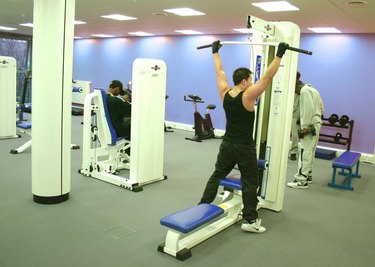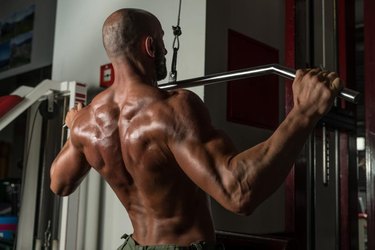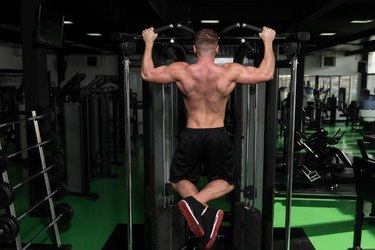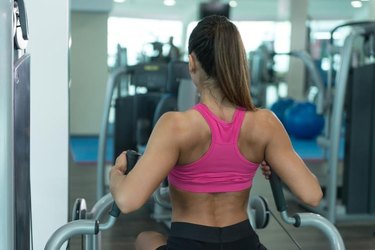
The sea of weight machines available on the gym floor may be enough to make you head right back out the exit. Knowing what to look for helps you navigate the floor with ease.
Workout machines that target your back are usually those that involve pulling, either in a rowing or upward direction. Once you know what you're looking for, you'll notice most facilities group them together to facilitate your workout.
Video of the Day
Video of the Day
Read More: What are the Benefits of Back Exercises?
Lat Pull Down
Many manufacturers produce a free-standing lat pull-down machine and their specs differ slightly among models. However, all share the same basic gist that targets the latissimus dorsi, the broad muscle of the back that covers the backs of the ribs. You pull handles or a bar down to your collarbones as you sit with your legs locked under a supportive pad. The downward action is what targets the back in a way similar to a pull-up.

Assisted Pull-up
The assisted pull-up machine isn't available at every gym, but if you have access to one, it's a nifty way to develop pull-up skills. The machine is hulking and features steps up to a platform that you stand or kneel on, depending on the model. Climb up and grasp the handles with a classic overhand wide grip, or choose one of the other options, such as chin-up or narrow grip. Conduct a pull-up just as you would without the help of the machine.

The way you select the weight on the assisted pull-up machine differs from other machines on the floor. For most machines, the higher you set the weight choice, the harder the exercise. The opposite is true for the assisted pull-up machine. The weight you choose represents the amount of assistance you're getting. So, when you choose a lower number, you're opting for less support from the machine and, thus, lifting a greater amount of your body weight. A higher number represents more assistance and less weight to pull up.
Rowing Machines
Multiple varieties of a rowing machine exist and all target your back from different directions and at various angles. A classic seated row machine with a pad to support your chest, works all of the muscles of the back. The standard model positions levels at your mid chest, but you'll find models of this machine with the levers angled up high, so you pull them back and down, as well as machines with the levers angled low, so you pull them back and up.
Incline row machines have you lie forward, rather than sit upright, on a padded bench. From this position you grasp the levers and pull them back with bent elbows. Don't confuse them with the T-bar row machine. This machine has you stand and straddle a lever; you then lean forward from your hips to grasp wide handles with an overhand grip. Pull the levers back with wide elbows to form a T-shape with your body.

Specialized Machines
Not all gyms offer the same array of machines. Less commonly found machines that work your back include:
The Iron Cross: You stand on a platform with handles positioned alongside your hips. Grasp the handles and raise your arms straight up and out to the sides to follow the track of the machine to target your lats.
The Shrug: You stand on a platform with the weight handles alongside your hips. Hold a handle in each hand and draw your shoulders up toward your ears to work your trapezius muscle, which is located in the upper and middle back region.
Pullover: This machine features a padded seat with a back rest. You reach up and slightly behind your head to catch a bar that you then pull down and in front of your torso. The motion looks like you're securing an amusement park ride safety bar.
Read More: How to Strengthen the Lower Back